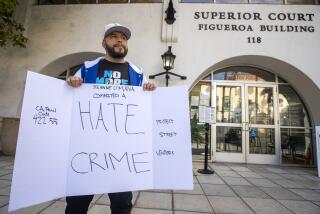Bloodless Battle : Neither Bull nor Matador Died, but Animal Rights Activists Clash With Organizers of Bullfight
- Share via
A bull charged back and forth under the matador’s red cape. A spectator, Manuel Pinheiro, beamed as a crowd laughed, cheered and shouted “Ole.”
Pointing to the arena’s dirt field and the wooden bleachers, he said: “This is tradition. It has big significance for the Portuguese people.”
But this wasn’t Portugal, and neither the bull nor the matador died.
Pinheiro, 57, was watching a bloodless bullfight in Artesia, home to about 2,500 Portuguese. Monday night about 1,500 people attended this final event of the Portuguese Festival of the Holy Ghost, an annual celebration put on by Artesia’s Divino Espirito Santo Hall, a Portuguese fraternal organization with close ties to the Catholic Church.
Group Protests
It turned out that the real contest was not between matador and bull, but between members of an organization called the Fund for Animals and the people who staged the bullfight.
About a dozen members of the Los Angeles chapter of Fund for Animals gathered at the hall to protest. Although the event was bloodless, members of the group said that the bulls are exploited and that any bullfight encourages brutal treatment of animals.
“Besides the fact that they are exploiting it, it is the taunting, teasing and tormenting of the animal that is abuse,” said Jerye Mooney, Los Angeles coordinator of Fund for Animals. Picketers carried signs proclaiming “Cruelty to Animals Is Not Entertainment” and “Teasing, Leaping Upon and Tail Pulling of Animals Is Cruelty.”
Some bullfight spectators shouted: “Go Home.”
“We feel this is not only cruel to animals, it is illegal,” Mooney said. “This is a shame for the community and a mockery of the church.”
State law prohibits bullfighting. Bloodless bullfighting is also banned except when it is part of a religious event or festival.
Called Entertainment
Mooney questioned whether the bullfight actually is a religious event. She said it is entertainment at the very end of the festival. Further, she said, the Catholic Church has condemned cruelty to animals.
But officials of Divino Espirito Santo Hall said that although this might not be an American Catholic event, it is a religious and cultural tradition unique to the Portuguese people.
The Fund for Animals had urged City Manager Lois O’Sullivan to stop the event, which has part of the annual four-day festival since 1976. But O’Sullivan, after consulting with the city attorney, said the event is legal “because there isn’t a statute against it.”
She said the law is “ambiguous” and that if city officials broke up the event, they would be in danger of making an unlawful arrest.
Mooney said similar bloodless bullfights in Long Beach, Ventura, Costa Mesa and Santa Clara have been halted by city officials who interpreted the law differently.
O’Sullivan attended the bullfight and said she plans to meet with event organizers to discuss the situation. But she would not say whether she thought the bullfight involved cruelty to animals.
“That’s for each of us to decide for ourselves,” she said.
Organizers said they in no way hurt the bull. Comparisons to bullfights in other countries, in which bulls are pierced and killed, are unwarranted, they said.
“You know the difference between the tuxedo and the blue jeans; that’s the difference,” Pinheiro said. “I like the animals as well as they do. You aren’t going to see a drop of blood in there.”
Pinheiro said he was afraid that “the man is going to be hurt, not the bull.”
During the bullfight, picadors attempted to touch the animal with Velcro-tipped sticks that attached to a Velcro cloth on the bull’s neck.
In another maneuver, called the pega, eight bullfighters tried to capture the bull by the horns by lining up single file, teasing the bull and grabbing it as it charged them head-on.
On the first try, the bullfighters failed, and the bull charged through them, sending them down like bowling pins. The second try was successful. The bull was grabbed by the horns and tail.
Officials from the county Animal Control and Sheriff’s departments were on hand to watch the bullfight. At the end, they had reported no violations.
“Quite honestly, the only abuse has been to the people unloading them (the bulls),” said Deputy George Vanecek. “I’ve seen no problems.”
One matador reported a twisted ankle, and another several bruises on his chin.
There was some criticism of the protesters.
“If they are going to protest about that, they are going to protest about anything,” said Gabe Azevedo, 21, who was born in Portugal. “It’s culture. I think they should wake up.”
Lina Leal, 25, said the protesters do not understand this as a religious tradition.
More to Read
Sign up for Essential California
The most important California stories and recommendations in your inbox every morning.
You may occasionally receive promotional content from the Los Angeles Times.










